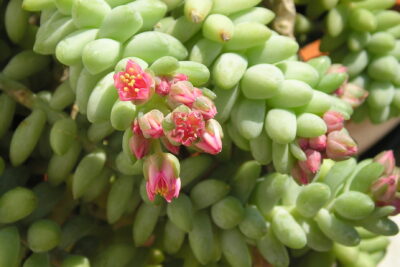
Exploring Tall Succulents: Natural Varieties and Growth Habits

Tall succulents are a fascinating and unique category of plants that have gained popularity among plant enthusiasts in recent years. While most people associate succulents with small, compact plants, there are actually several species that grow vertically and can reach impressive heights. These tall succulents not only add a striking visual element to any garden or indoor space, but they also offer interesting growth habits and require specific care.
We will delve into the world of tall succulents, exploring the natural varieties and growth habits that make them so intriguing. We will discuss some of the most popular tall succulent species, such as the Aloe polyphylla and the Euphorbia ingens, and examine their unique characteristics. Additionally, we will provide tips and tricks for growing and caring for tall succulents, including the ideal conditions, watering requirements, and propagation methods. Whether you're a seasoned succulent enthusiast or just starting to explore the world of plants, this article will serve as a comprehensive guide to understanding and cultivating tall succulents.
- Tall succulents can add height and visual interest to your garden or indoor space
- Some popular tall succulent varieties include Aloe vera, Agave americana, and Euphorbia tirucalli
- These succulents have different growth habits, with some forming rosettes and others growing in a more columnar shape
- Provide ample sunlight and well-draining soil for tall succulents to thrive
- Water tall succulents sparingly, allowing the soil to dry out between waterings
- Prune tall succulents to maintain their shape and remove any dead or damaged leaves
- Propagate tall succulents by taking stem cuttings and allowing them to root in well-draining soil
- Consider using tall succulents as focal points in your garden or as statement plants in larger containers
- Frequently Asked Questions
Tall succulents can add height and visual interest to your garden or indoor space
When it comes to succulents, most people envision small, compact plants that are perfect for windowsills or tabletop arrangements. However, there is a whole world of tall succulents that can bring a unique touch to your garden or indoor space. These plants not only add height but also offer a striking visual interest with their diverse growth habits and natural varieties.
Growth Habits of Tall Succulents
Tall succulents come in various growth habits, each with its charm and appeal. Some succulents grow upright, reaching for the sky with their tall, sturdy stems. These include species like the Euphorbia trigona or the Aloe vera, which can grow several feet tall. They create a dramatic focal point in any garden or room.
On the other hand, some tall succulents have a sprawling or climbing growth habit. These plants, such as the Senecio radicans or the String of Bananas (Senecio radicans), cascade down from hanging baskets or spill over the edges of containers. Their long, trailing stems add an elegant touch to any space.
Natural Varieties of Tall Succulents
The world of tall succulents is full of diverse and captivating natural varieties. One popular variety is the Echeveria 'Lola', which features rosettes of overlapping leaves that can reach up to eight inches tall. Another fascinating variety is the Agave americana, also known as the Century Plant, which can grow up to six feet tall and features stunning blue-green leaves with spiky edges.
- Echeveria 'Lola': Rosettes of overlapping leaves, up to eight inches tall.
- Agave americana: Also known as the Century Plant, grows up to six feet tall with spiky blue-green leaves.
Other tall succulent varieties include the Sansevieria cylindrica, commonly known as the Snake Plant or African Spear, with its long, cylindrical leaves that can grow up to three feet tall. The Kalanchoe beharensis, also known as the Velvet Elephant Ear, stands out with its large, fuzzy leaves that can reach up to two feet tall.
 The Truth about Growing a Green Rose Succulent at Home
The Truth about Growing a Green Rose Succulent at HomeAdding Tall Succulents to Your Space
To incorporate tall succulents into your garden or indoor space, consider their growth habits and natural varieties. If you have ample vertical space, opt for upright-growing succulents like Euphorbia trigona or Aloe vera. These can be placed as standalone plants or grouped together to create a visually striking arrangement.
For those with limited space, trailing or climbing succulents like Senecio radicans or String of Bananas are an excellent choice. Hang them in baskets or place them on high shelves to let their stems cascade down gracefully.
Remember to provide these tall succulents with adequate sunlight, well-draining soil, and occasional waterings. With proper care, they will thrive and bring a touch of natural beauty to your surroundings.
In Conclusion
Tall succulents are not only unique but also offer a refreshing change from the typical small succulents that are commonly seen. Whether you prefer upright-growing plants or trailing varieties, there is a tall succulent to suit every taste and space. Experiment with different growth habits and natural varieties to create stunning displays that will leave your guests in awe.
Some popular tall succulent varieties include Aloe vera, Agave americana, and Euphorbia tirucalli
Aloe vera
Aloe vera is a well-known succulent that can grow up to 2 feet tall. It is characterized by its fleshy, green leaves that have a gel-like substance inside. This plant is not only popular for its ornamental value but also for its medicinal properties. The gel found in the leaves of Aloe vera has been used for centuries to treat burns, skin irritations, and other ailments.
 Vibrant & Colorful Succulent Plants for Your Garden
Vibrant & Colorful Succulent Plants for Your GardenAgave americana
Agave americana, commonly known as the century plant, is a striking succulent that can reach heights of up to 6 feet. It has large, stiff leaves with sharp spines along the edges. This succulent is native to Mexico but has been widely cultivated around the world. Its impressive size and architectural form make it a popular choice for landscaping.
Euphorbia tirucalli
Euphorbia tirucalli, also known as the pencil cactus or firestick plant, is a tall succulent that can grow up to 20 feet in height. It is characterized by its slender, pencil-like stems that are green or red in color. This succulent is native to Africa and is often used as a striking accent plant in gardens and landscapes.
Tall succulents like Aloe vera, Agave americana, and Euphorbia tirucalli can add a unique and dramatic element to any garden or indoor space. Their varying growth habits and striking appearances make them a popular choice among succulent enthusiasts and gardeners alike.
These succulents have different growth habits, with some forming rosettes and others growing in a more columnar shape
When it comes to succulents, there is a wide variety of growth habits to explore. Some succulents have a unique way of growing, forming rosettes, while others have a more columnar shape. Let's take a closer look at these fascinating tall succulents and their natural varieties.
 Choosing the Best Succulent Varieties for Your Garden
Choosing the Best Succulent Varieties for Your GardenRosette-forming Succulents
One of the most common growth habits among tall succulents is the rosette formation. These succulents grow in a circular shape, with the leaves radiating from the center. The leaves are often thick and fleshy, allowing them to store water and withstand dry conditions. Some popular rosette-forming succulents include:
- Aloe vera: Known for its medicinal properties, Aloe vera forms beautiful rosettes with long, pointed leaves.
- Echeveria: This genus offers a wide range of rosette-forming succulents, with varying colors and textures.
- Haworthia: Haworthia species often have rosettes with distinct patterns and markings, making them a visually appealing choice for succulent enthusiasts.
These rosette-forming succulents are not only attractive but also relatively easy to care for, making them a popular choice for both beginners and experienced gardeners.
Columnar Succulents
In contrast to rosette-forming succulents, there are tall succulents that grow in a columnar shape. These succulents have a more upright growth habit, with their leaves or stems growing vertically. Some notable columnar succulents include:
- Senecio mandraliscae: Also known as "Blue Chalksticks," this succulent features long, bluish-gray stems that create an eye-catching columnar effect.
- Euphorbia trigona: Commonly referred to as "African Milk Tree," this succulent has multiple upright stems, forming a cactus-like appearance.
- Cereus peruvianus: Often called "Peruvian Apple Cactus," this tall succulent has ribbed stems that can grow up to several meters in height.
Columnar succulents add a vertical element to any garden or indoor space. Their tall and slender growth habit makes them perfect for creating focal points or adding height to succulent arrangements.
Whether you prefer the charming rosette formation or the elegant columnar shape, tall succulents offer a diverse range of growth habits to explore. Incorporating these unique succulents into your collection will not only enhance the visual appeal but also provide an interesting contrast to other plants in your garden.
Provide ample sunlight and well-draining soil for tall succulents to thrive
Tall succulents have gained popularity in recent years due to their unique and striking appearance. With their elongated stems and rosettes reaching for the sky, these plants add a vertical dimension to any garden or indoor space. To ensure the healthy growth of tall succulents, it is crucial to provide them with ample sunlight and well-draining soil.
 Popular Succulent Varieties: Exploring Selections in a Pagoda Village
Popular Succulent Varieties: Exploring Selections in a Pagoda Village1. Sunlight requirements
Tall succulents, like all succulents, are sun-loving plants. They thrive in bright, indirect sunlight for several hours a day. When selecting a location for your tall succulents, choose a spot that receives at least 6-8 hours of sunlight per day. Placing them near a south-facing window or outdoors in a sunny area will provide them with the necessary light.
Keep in mind that while tall succulents need sunlight, they should be protected from intense and direct sunlight during the hottest parts of the day, especially during summer months. This can be achieved by providing them with some shade or by using sheer curtains or blinds to filter the sunlight.
2. Soil requirements
The second essential aspect for the successful growth of tall succulents is well-draining soil. Succulents are adapted to arid environments and are prone to root rot if their roots sit in waterlogged soil for extended periods.
When selecting soil for your tall succulents, opt for a well-draining mix specifically formulated for succulents or cacti. These mixes typically contain a combination of organic matter, such as peat moss or coconut coir, and inorganic materials like perlite or pumice. This blend promotes proper drainage and prevents waterlogged roots.
It is crucial to avoid using regular potting soil or garden soil for tall succulents, as these tend to retain moisture for longer periods, leading to root rot and other moisture-related issues.
3. Watering considerations
Tall succulents have water-storing capabilities in their leaves and stems, allowing them to withstand periods of drought. As a general rule, it is better to underwater than overwater tall succulents.
Water your tall succulents when the soil is completely dry, and the leaves show signs of wrinkling or drooping. Be mindful not to water them too frequently, as this can lead to root rot. Additionally, it is advisable to water the soil directly rather than spraying the leaves to prevent excess moisture from accumulating in the rosettes and causing rot or fungal diseases.
 Discover the Beauty of Yellow Flowering Succulent Ground Cover Plants
Discover the Beauty of Yellow Flowering Succulent Ground Cover PlantsRemember, each succulent species has its own specific watering needs, so it's essential to research and understand the requirements of the specific tall succulents you are growing.
- Tip: To check if your tall succulents need watering, insert your finger into the soil. If it feels dry up to the first knuckle, it's time to water them.
By providing adequate sunlight, well-draining soil, and proper watering, you can ensure the healthy growth and longevity of your tall succulents. These fascinating plants will reward you with their stunning vertical presence while adding a touch of uniqueness to your garden or indoor space.
Water tall succulents sparingly, allowing the soil to dry out between waterings
Tall succulents, with their unique growth habits and natural varieties, are a fascinating addition to any garden or indoor plant collection. These plants have evolved to thrive in arid and dry conditions, making them excellent choices for those with a less-than-green thumb.
One important aspect to consider when caring for tall succulents is their watering needs. Unlike other plants, succulents store water in their leaves, stems, and roots, allowing them to survive in drought-like conditions. Therefore, it is crucial to water tall succulents sparingly and let the soil dry out between waterings.
Overwatering can be detrimental to the health of tall succulents, as it can lead to root rot and other issues. To prevent this, it is recommended to use a well-draining soil mix specifically designed for succulents. This type of soil allows excess water to drain away quickly, preventing waterlogged roots.
When watering tall succulents, it's best to water deeply and thoroughly, ensuring that the entire root system receives moisture. A good practice is to wait until the soil is completely dry before watering again. This allows the roots to absorb water efficiently and promotes healthy growth.
 Find the Perfect Pink Flowering Succulent Vine
Find the Perfect Pink Flowering Succulent VineRemember, each succulent variety may have slightly different watering needs, so it's essential to observe your plants closely and adjust your watering schedule accordingly. Some tall succulents, like the Agave or Yucca, are more drought-tolerant and can withstand longer periods without water, while others, such as Aloe vera, may require more frequent watering.
Tip: To check if it's time to water your tall succulents, simply insert your finger about an inch into the soil. If it feels dry, it's time to water. If it still feels slightly damp, wait a few more days before watering.
Prune tall succulents to maintain their shape and remove any dead or damaged leaves
Tall succulents can be a stunning addition to any garden or indoor space. Their unique growth habits and natural varieties offer a captivating display of shapes and colors. However, to ensure that your tall succulents continue to thrive and maintain their desired shape, it is important to prune them regularly.
Pruning tall succulents serves two main purposes: shaping and maintenance. Shaping involves trimming and directing the growth of the plant to achieve the desired appearance. Maintenance, on the other hand, involves the removal of any dead or damaged leaves to promote overall plant health.
When it comes to shaping tall succulents, it is crucial to consider their growth habits. Some succulents naturally grow tall and slender, while others have a more bushy or sprawling growth pattern. By understanding the growth habit of your succulent, you can prune it accordingly to enhance its natural form. For instance, you may want to trim back any leggy growth to encourage the plant to grow bushier or cut off any wayward branches to maintain a more compact shape.
Regular pruning also helps to remove any dead or damaged leaves, which can be unsightly and potentially harmful to the overall health of the plant. Dead leaves can become a breeding ground for pests or diseases, so it is important to remove them promptly. By pruning away these leaves, you not only improve the aesthetics of your succulent but also create a healthier environment for its growth.
 Unusual Colors in Succulent Foliage: Are Pink Leaves Normal?
Unusual Colors in Succulent Foliage: Are Pink Leaves Normal?When pruning tall succulents, it is recommended to use clean and sharp pruning shears or scissors. This ensures a clean cut and reduces the risk of introducing infections or diseases to the plant. Additionally, it is important to be mindful of the succulent's growth points or rosettes, as these are where new growth emerges. Avoid cutting too close to these points to prevent stunting the plant's growth.
Pruning tall succulents is essential for maintaining their shape and promoting overall plant health. By understanding their growth habits and using proper pruning techniques, you can ensure that your tall succulents continue to thrive and showcase their natural beauty.
Propagate tall succulents by taking stem cuttings and allowing them to root in well-draining soil
When it comes to propagating tall succulents, one of the most effective methods is taking stem cuttings and allowing them to root in well-draining soil. This process is relatively straightforward and can be done with a few simple steps.
Step 1: Selecting the Stem Cutting
Begin by choosing a healthy, mature stem on the succulent plant. Look for a stem that is free from any signs of damage or disease. Using a clean, sharp pair of scissors or pruning shears, make a clean cut just below a node or leaf. The cutting should be approximately 4-6 inches in length.
Step 2: Allowing the Cutting to Callus
After taking the stem cutting, it is important to allow it to dry and form a callus. This helps to prevent rotting and promotes successful rooting. Place the cutting in a warm, dry location away from direct sunlight and let it sit for about a week. During this time, the cut end will callus over.
 Top Choices: Popular Flowering Succulent House Plants for Your Home
Top Choices: Popular Flowering Succulent House Plants for Your HomeStep 3: Preparing the Soil
While the cutting is callusing, prepare a well-draining soil mixture. Succulents thrive in soil that allows water to pass through quickly and prevents waterlogging. A recommended soil mix for succulent propagation is a combination of coarse sand, perlite, and potting soil. Mix the ingredients thoroughly to ensure a balanced mixture.
Step 4: Planting the Cutting
Once the cutting has formed a callus and the soil is ready, it's time to plant the cutting. Create a small hole in the soil mixture and gently insert the cut end of the stem into the hole. Ensure that the cutting is upright and stable. Lightly pack the soil around the base of the cutting to provide support.
Step 5: Watering and Care
After planting the cutting, water it lightly to settle the soil. Be careful not to overwater, as excessive moisture can lead to rotting. Place the newly planted cutting in a location that receives bright but indirect sunlight. Avoid placing it in direct sunlight, as this can cause sunburn or scorching.
Monitor the cutting regularly and water only when the soil is completely dry. Over time, you will start to see new root growth from the base of the cutting. This indicates successful rooting, and you can gradually increase the frequency and amount of water given to the plant.
 Discover a Diverse Selection of Vibrant Colored Succulent Plants
Discover a Diverse Selection of Vibrant Colored Succulent PlantsBy following these steps, you can successfully propagate tall succulents using stem cuttings. With patience and proper care, you will soon have new plants to add to your succulent collection.
Consider using tall succulents as focal points in your garden or as statement plants in larger containers
Tall succulents are a unique and captivating addition to any garden or container. Their impressive height and striking growth habits make them wonderful focal points that instantly grab attention. Whether you want to add drama to your outdoor space or create a stunning centerpiece for your patio, tall succulents are a fantastic choice.
One of the most remarkable qualities of tall succulents is their ability to grow upwards towards the sky. Unlike other plants that spread outwards or cascade downwards, these succulents shoot up vertically, creating an eye-catching display. Their upward growth habit makes them perfect for adding vertical interest to your garden or container arrangements.
Natural Varieties of Tall Succulents
There are several natural varieties of tall succulents that you can consider for your garden. One popular choice is the Agave Americana, also known as the century plant. This striking succulent can grow up to 6 feet tall and features thick, fleshy leaves with sharp spines. Its architectural form and blue-green color make it a stunning addition to any landscape.
The Euphorbia Ingens, commonly known as the candelabra tree, is another tall succulent that can reach heights of up to 30 feet. This tree-like succulent has thick, segmented stems that resemble the branches of a candelabra. Its unique shape and ability to grow tall and slender make it a standout plant in any setting.
Growth Habits of Tall Succulents
Tall succulents have a variety of growth habits that add to their appeal. Some succulents, like the Aloe Vera, grow in a rosette pattern with leaves radiating outwards from a central point. Others, like the Sansevieria or snake plant, grow in tall, upright clusters that resemble spears. These growth habits contribute to their visual interest and create a dynamic contrast in your garden or container arrangements.
 Low-Water Succulents: Discovering Thin-Leafed Varieties
Low-Water Succulents: Discovering Thin-Leafed VarietiesIt's important to note that tall succulents may require more space and care compared to their shorter counterparts. Due to their size, they often have more extensive root systems and need adequate room to spread out. Additionally, they may have different water and light requirements, so it's essential to research and understand the specific needs of the tall succulents you choose.
So, if you're looking for a stunning addition to your garden or container, consider incorporating tall succulents. With their natural varieties and unique growth habits, they are sure to make a bold statement and add an element of visual interest to any space.
Frequently Asked Questions
1. What are tall succulents?
Tall succulents are a group of plants that belong to the succulent family and have a vertical growth habit, often reaching heights of several feet.
2. Are tall succulents easy to care for?
Yes, tall succulents are generally low maintenance plants. They require well-draining soil, occasional watering, and plenty of sunlight to thrive.
3. What are some examples of tall succulents?
Some common examples of tall succulents include Agave americana, Aloe arborescens, and Euphorbia ingens.
4. Can tall succulents be grown indoors?
While some tall succulents can be grown indoors, they typically require a lot of sunlight. It's important to place them near a window with direct sunlight or provide artificial grow lights for sufficient light intensity.
If you want to read more articles similar to Exploring Tall Succulents: Natural Varieties and Growth Habits, you can visit the Varieties and Colors category.






You Must Read